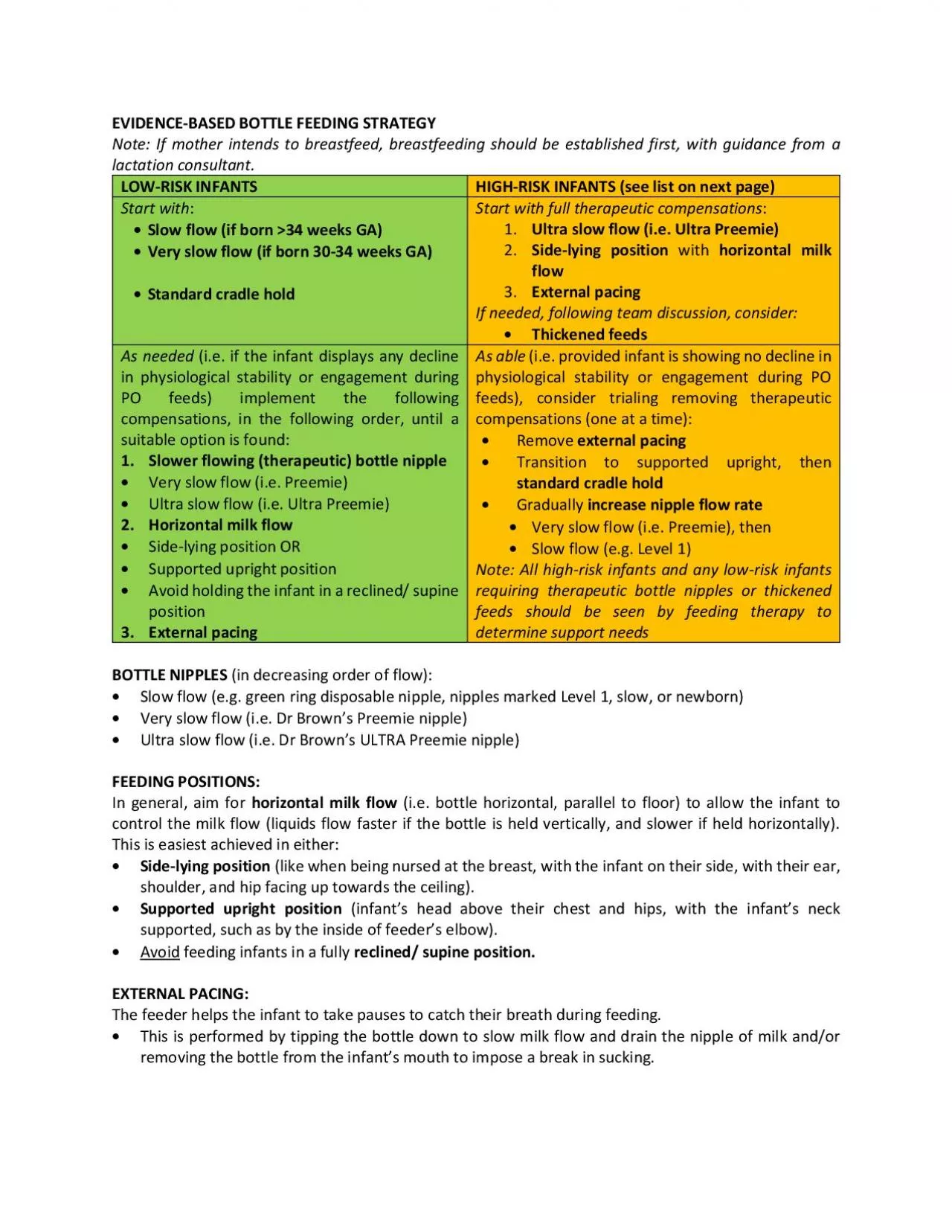

EVIDENCE Note If mother intends to breastfeed breastfeeding should be established first with guidance from a lactation consultant LOW RISK INFANTS HIGH RISK INFANTS see list on next pag ID: 938083
Download Pdf The PPT/PDF document "BASED BOTTLE FEEDING STRATEGY" is the property of its rightful owner. Permission is granted to download and print the materials on this web site for personal, non-commercial use only, and to display it on your personal computer provided you do not modify the materials and that you retain all copyright notices contained in the materials. By downloading content from our website, you accept the terms of this agreement.
EVIDENCE - BASED BOTTLE FEEDING STRATEGY Note: If mother intends to breastfeed, breastfeeding should be established first, with guidance from a lactation consultant. LOW - RISK INFANTS HIGH - RISK INFANTS ( see list on next page ) Start with : • Slow flow (if born �34 weeks GA) • Very slow flow (if born 30 - 34 weeks GA) • Standard cradle hold Start with full therapeutic compensations : 1. Ultra slow flow (i.e. Ultra Preemie) 2. Side - lying position with horizontal milk flow 3. External pacing If needed, following team discussion, consider: • Thickened feeds As needed (i.e. if the infant displays any decline in physiological stability or engagement during PO feeds) implement the following compensations, in the following order, until a suitable option is fou nd: 1. Slower flowing (therapeutic) bottle nipple • Very slow flow (i.e. Preemie) • Ultra slow flow (i.e. Ultra Preemie) 2. Horizontal milk flow • Side - lying position OR • Supported upright position • Avoid holding the infant in a reclined/ supine position 3. External pacing As able (i.e. provided infant is showing no decline in physiological stability or engagement during PO feeds), consider trialing removing therapeutic compensations (one at a time): • Remove external pacing • Transition to supported upright, th en standard cradle hold • Gradually increase nipple flow rate • Very slow flow (i.e. Preemie) , then • Slow flow (e.g. Level 1) Note: All high - risk infants and any low - risk infants requiring therapeutic bottle nipples or thickened feeds should be seen by feeding therapy to determine support needs BOTTLE NIPPLES (in decreasing order of flow): • Slow flow (e.g. green ring disposable nipple, nipples marked Level 1, slow, or newborn) • Very slow flow (i.e. Dr Brown’s Preemie nipple) • Ultra slow flow (i.e. Dr Brown’s ULTRA Preemie nipple) FEEDING POSITIONS: In general, aim for horizontal milk flow (i.e. bottle horizontal, parall el to floor) to allow the infant to control the milk flow (liquids flow faster if the bottle is held vertically, and slower if held horizontally). This is easiest achieved in either: • Side - lying position (like when being nursed at the breast, with the inf ant on their side, with their ear, shoulder, and hip facing up towards the ceiling). • Supported upright position (infant’s head above their chest and hips, with the infant’s neck supported, such as by the inside of feeder’s elbow)
. • Avoid feeding infants in a fully reclined/ supine position. EXTERNAL PACING: The feeder helps the infant to take pauses to catch their breath during feeding. • This is performed by tipping the bottle down to slow milk flow and drain the nipple of milk and/or removing the bottle from the infant’s mouth to impose a break in sucking. HIGH - RISK INFANTS (i.e. infants at increased risk of as piration/ adverse events during PO feeding) • Born 30/40 weeks GA • Bronchopulmonary dysplasia (BPD) • Congenital heart disease (CHD) with altered respiratory parameters • Airway malformation (e.g. laryngomalacia, laryngeal cleft , vocal fold paralysis ) • Neurological injury or altered neurological state: (e.g. IVH grade 3 or 4, moderate - severe HIE, seizures; those on anti - epileptic drugs or sedatives) • Certain genetic syndromes associated with high aspiration risk (e.g. Down syndrome, Prader Willi syndrome ) • Any infant who shows any adverse clinical events during PO feeding (e.g. SpO2 desaturation, apnea, bradycardia, wet vocalizations, cough, ‘choke’). • Note: Infants who are on positive pressure support ( CPAP / HFNC ) , or who are tachypneic (RR � 70BPM) should not be fed PO at that time Stages of infant feeding maturation Mature Integrated suck - swallow - breath pattern (1:1:1) Intermediate Bursts of multiple suck - swallows followed by a self - imposed break to catch breath (infant display s self - pa cing ) Beginner Bursts of multiple suck - swallows without a break to catch breath; the feeder needs to assist the infant to take breaks to catch their breath or adverse event (SpO2 desaturation, apnea, bradycardia event, or aspiration) may occur ( infant requi res external pacing ) Boston Infant Feeding Scale Overall PO feeding status: 1 Competent feeder 2 Functional feeder with therapeutic compensations ( any or all of the following): • Slower flowing bottle nipple (i.e. very slow flow, ultra slow flow) • Altered positioning (e.g. side - lying position with horizontal milk flow) • External pacing (i.e. tipping the bottle down and/or removing from the infant’s mouth to slow milk flow and impose break in sucking for them to catch breath) 3 Struggling/ beginner feeder despite compensations 4 Not ready for PO feeds Current route for feeds: A PO B PO with close monitoring C PO with PG top - up as required D All PG with conservative PO trials E All PG (nothing by mouth) PO – by mouth PG – by gavage